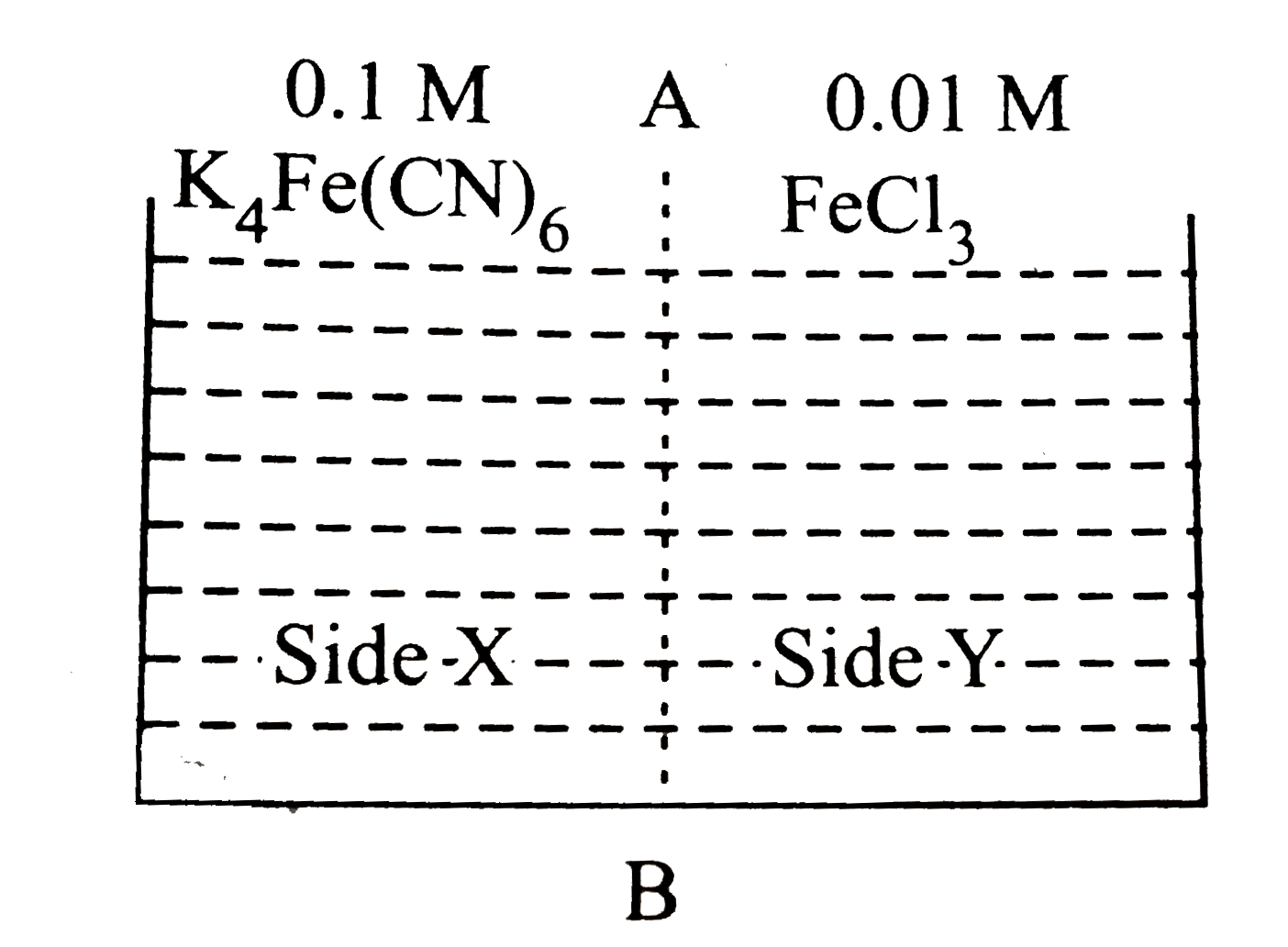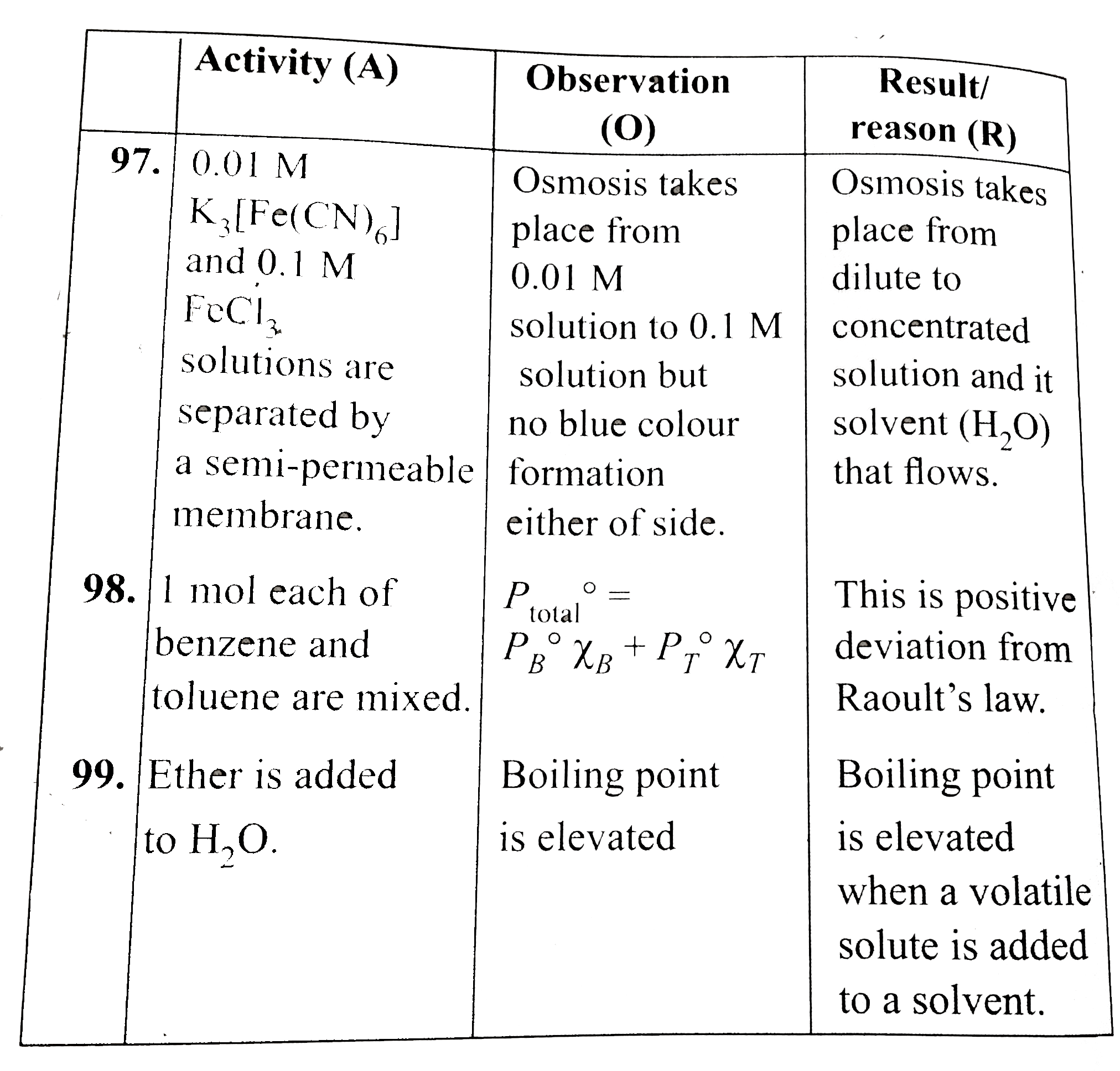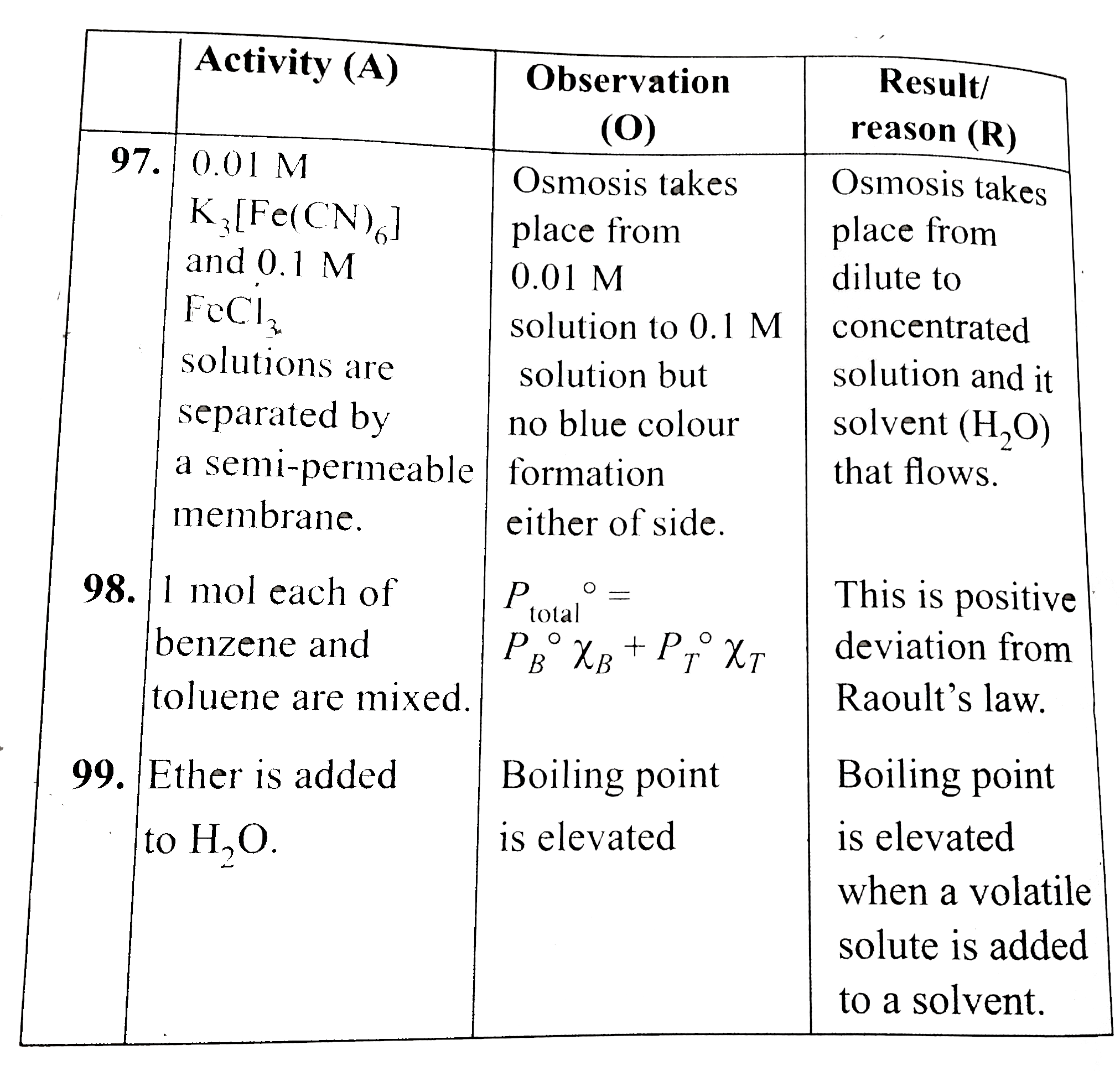Complete Solutions to Exercises (Single Correct) of chapter SOLUTIONS of Class 12 book with complete answers and questions
| Class 12 | CHEMISTRY |
| Chapter | SOLUTIONS |
| CENGAGE CHEMISTRY | Exercises (Single Correct) |
| Number Of Questions | 99 |
| Academic Year | 2023-24 |
The use of common salts, e.g., `NaCl` or `CaCl_(2)` anhydrous, is made to clear snow on the rods. This causes:
03:05View SolutionThe relative lowering of vapour pressure is equal to the mole fraction of the non-volatile solute. This statement was given by
01:46View SolutionAssuming each salt to be `90%` dissociated which of the following will have highest osmotic pressure ?
01:44View SolutionWhen a solution is separated from a solvent by a semi-permeable membrane, then the phenomenon taking place is called as
01:49View SolutionIf a thin slice of sugar beet is placed in concentrated solution of `NaCl`, then
03:07View SolutionThe boiling point of an azeotropic mixture of water and ethyl alcohol is less than that of the theoretical value of water and alcohol mixture. Hence the mixture shows
03:29View SolutionWhich salt shows maximum osmotic pressure in its `1 m` solution.
02:33View SolutionSolution distilled without change in composition at a temperature is called
01:22View SolutionAzeotropic mixtures are
01:37View SolutionWhich solution will show maximum elevation in boiling point?
02:32View SolutionOn mixing `10 mL` of acetone with `40 mL` of chloroform,the total volume of the solution is
02:08View SolutionWhen common salt is dissolved in water
03:01View SolutionWhich of the following substances will lose its whose solubility with increase in temperature?
03:36View SolutionOn mixing `10 mL` of carbon tetrachloride with `10 mL` of benzene the total volume of the solution is:
01:59View SolutionA teacher one day pointed out to his students the peculiar fact that water is a unique liquid which freezes exactly at `0^(@)C`.and boils exactly at `100^(@)C`. He asked the students to find the correct statement based on this fact.
05:56View SolutionThe osmotic pressure of a dilute solution is directly proportional to the
03:15View SolutionIf Raoult's law is obeyed, the vapour pressure of the solvent in a solution is directly proportional to
02:13View SolutionThe freezing point of `1%` aqueous solution of calcuim nitrate will be
02:01View SolutionA perfectly semi-permeable membrane when used to separate a solution from its solvent permits through it the passage of
02:17View SolutionEach pair forms ideal solution except
03:10View SolutionWhich statement is incorrect about osmotic pressure`(pi)`, volume `(V)`, and temperature `(T)`?
03:00View SolutionSemi-permeable membrane is chemically
01:49View SolutionAn aqueous solution of methanol in water has vapour pressure
03:24View SolutionThe depression in freezing point is maximum if the solvent used is
02:06View SolutionThe osmotic pressure of a dilute solution is given by
02:12View SolutionWhich is not a colligative property?
02:19View SolutionBlood has been found to be isotonic with
02:21View SolutionWhich condition is not satisfied by an ideal solution?
02:57View SolutionIsotonic solutions are those which have
03:20View SolutionThe correct relationship between the boiling points of very dilute solutions of `AlCl_(3) (t_(1))` and `CaCl_(2)(t_(2))`, having the same molar concentration, is
02:14View SolutionTwo solutions of `KNO_(3)` and `CH_(3)COOH` are prepared separately. The molarity of both is `0.1 M` and osmotic pressure is `P_(1)` and `P_(2)`, respectively.
The correct relationship between the osmotic pressure is03:45View SolutionBoiling point elevation is
01:32View SolutionAn example of colligative property is
02:02View SolutionA mixture of benzene and toluence forms
03:10View SolutionThe colligative properties of a solution depend on
03:25View SolutionOsmosis is the spontaneous flow through a semi-permeable membrane of
02:53View SolutionThe osmotic pressure of a non-aqueous solution is measured by
02:39View SolutionA pressure cooker reduces cooking time because
01:56View SolutionThe osmotic pressure of a solution increases if
02:39View SolutionThe ratio of the value of any colligative property of `KCl` solution to that of sugar solution is
03:03View SolutionEquimolal solutions `A` and `B` show depression in freezing point in the ratio `2:1`. A remains in the normal state in solution. `B` will be
03:22View SolutionThe vapour pressure `(VP)` of a dilute solution of non-volatile solute is `P` and the `VP` of a pure solvent is `P^(@)`. The lowering of the `VP` is
01:58View SolutionIf `P^(@)` and `P_(s)` are vapour pressure of solvent and its solution, respectively, `chi_(1)` and `chi_(2)` are mole fractions of solvent and solute, respectively, then
03:04View SolutionThe value of `K_(f)`for water is `1.86^(@)`, calculated from glucose solution, The value of `K_(f)`for water calculated for NaCl solution will be,
01:55View SolutionWhat will be the molecular weight of `NaCl` determined experimentally following elevation in the boiling point or depression in freezing point method?
03:39View SolutionThe van't Hoff factor of `NaCl` assuming `100%` dissociation is:
00:53View SolutionThe solution in which the blood cells remain their normal shape, with regard to the blood, are
03:32View SolutionThe factor `(DeltaT_(f)//K_(f))` represents
02:33View SolutionWhich aqueous solution has minimum freezing point?
01:59View SolutionWhich aqueous will have the highest boiling point?
04:00View SolutionWhich of the following solutions has the minimum freezing point
03:37View SolutionThe osmotic pressure of equimolar solutions of `BaCl_(2)`,`NaCl`,and glucose follow the order
03:09View SolutionWhich of the following solutions has the maximum freezing point?
01:52View SolutionThe osmotic pressure of a `5% (weight// volume)` solution of cane sugar at `150^(@)C` is
02:06View SolutionThe freezing point of a `0.05` molal solution of a non-electrolyte in water is:
(`K_(f) = 1.86 "molality"^(-1)`)01:17View SolutionThe freezing point of `1` molal `NaCl` solution assuming `NaCl` to be `100%` dissociated in water is:
02:18View SolutionThe molal freezing point constant of water is `1.86 K m^(-1)`. If `342 g` of cane sugar `(C_(12)H_(22)O_(11))` is dissolved in `1000 g` of water, the solution will freeze at
02:16View SolutionThe oscotic pressure of a solution containing `0.1 mol` of solute per litre at `273 K` is
01:56View SolutionOsmotic pressure of `40%` (wt.`//`vol.) urea solution is `1.64 atm` and that of `3.42%` (wt.`//`vol.) cane sugar is `2.46 atm`. When equal volumes of the above two solutions are mixed, the osmotic pressure of the resulting solution is:
04:37View SolutionDry air was passed successively through solution of `5g` of a solute in `180g` of water and then through pure water. The loss in weight of solution was `2.50 g` and that of pure solvent `0.04g`. The molecualr weight of the solute is:
02:13View SolutionThe osmotic pressure of a solution (density is 1 g `mL^(-1))` containing `3 g` of glucose (molecular weight =180) in `60 g` of water at `15^(@)C` is
02:49View SolutionWhat should be the freezing point of aqueous solution containing `17g` of `C_(2)H(5)OH` is `1000g` of water (`K_(f)` for water =`1.86 deg kg mol^(-1)`)?
03:43View SolutionA solution containing `8.6 g` urea in `1 L` was found to be isotonic with `5%(weight//volume)` solution of an organic non-volatile solute. The molecular weight of latter is
03:17View SolutionA solution containing `4 g` of a non-volatile organic solute per `100 mL` was found to have an osmotic pressure equal to `500 cm` of mercury at `27^(@)C`. The molecular weight of solute is
02:39View SolutionThe molal elevation constant of water =`0.52 K m^(-1)`. The boiling point of `1.0 molal` aqueous `KCl` solution (assuming complete dissociation of `KCl`) should be
02:12View SolutionIf a `6.84% (weight//volume)` solution of cane sugar (molecular weight=342) is isotonic with `1.52%(weight//volume)`solution of thiocarbamide, then the molecular weight of thiocarbamide is
03:07View SolutionThe osmotic pressure of a sugar solution at `24^(@)C` is `2.5 atm`. The concentration of the solution in mole per litre is
02:12View SolutionAt `40^(@)C` the vapour pressure of pure liquids, benzene and toluene, are `160 mm Hg` and `60 mm Hg` respectively. At the same temperature, the vapour pressure of an equimolar solution of the liquids, assuming the ideal solution will be:
01:52View SolutionThe Van't Hoff factor of very dilute solution of `Ca(NO_(3))_(2)`
01:30View SolutionLowering in vapour pressure is highest for
03:47View SolutionAn azeotropic mixture of `HCl` and water has
02:42View SolutionWhich of the following will have the highest boiling point at `1 atm` pressure?
03:30View SolutionAn ideal solution was obtained by mixing methanol and ethanol. If the partial vapour pressure of methanol and ethanol are `2.619 kPa` and `4.556 kPa`, respectively, the composition of vapour (in terms of mole fraction) will be
03:50View SolutionAn aqueous solution freezes at
`-0.186^(@)C (K_(f)=1.86^(@)` ,`K_(b)=0.512^(@)`. What is the elevation in boiling point?02:15View SolutionThe vapour pressure of a solvent decreased by `10 mm` of `Hg` when a non-volatile solute was added to the solvent. The mole fraction of solute is `0.2`, what would be the mole fraction of solvent if the decrease in vapour pressure is `20 mm` of `Hg`.
03:48View SolutionThe molal depression constant for water is `1.86^(@)C`. The freezing point of a `0.05-molal` solution of a non-electrolyte in water is
01:50View SolutionThe freezing point of a solution prepared from `1.25 g` of non-electrolyte and `20 g` of water is `271.9 K`. If the molar depression constant is `1.86 K mol^(-1)`, then molar mass of the solute will be
02:38View SolutionA `5%` solution of cane sugar (molecular weight=342) is isotonic with `1%` solution of substance `X`.The molecular weight of `X` is
03:01View SolutionThe mole fraction of toluene in the vapour phase which is in equilibrium with a solution of benzene `(P_(B)^(@)=120 "torr")` and toluene `(P_(T)^(@)=80 "torr")` having `2.0 mol` of each, is
02:54View SolutionTotal Vapour pressure of mixture of 1molA`(p_(A)^(0)=150 "torr")`and 2molB `(p_(B)^(0)=240 "torr")`is `200 "torr"`. In this case
01:59View SolutionThe vapour pressure of pure benzene `C_(6)H_(6)` at `50^(@)C` is `268 "torr"`. How many moles of non-volatile solute per mole of benzene is required to prepare a solution of benzene having a vapour pressure of `167 "torr"` at `50^(@)C`?
02:49View SolutionThe osmotic pressure of blood is 7.40 atm at `27^(@) C`.The number of mol of glucose to be used per litre for an intravenous injection that is to have the same osmotic pressure as blood is
02:05View Solution`PtCl_(4).6H_(2)O` can exist as a hydrated complex. `1 m` aqueous solution has the depression in freezing point of `3.72^(@)`. Assume `100%` ionization and `K_(f)(H_(2)O)=1.86^(@)mol^(-1) kg`, then the complex is
04:12View SolutionWhich of the following solutions `(1 molal)` will have the maximum freezing point, assuming equal ionization in each case?
03:20View SolutionThe depression in freezing point of `0.01 m` aqueous `CH_(3)CooH` solution is `0.02046^(@)`, `1 m` urea solution freezes at `-1.86^(@)C`. Assuming molality equal to molarity, `pH` of `CH_(3)COOH` solution is
05:19View SolutionpH of `0.1` M monobasic acid is found to be 2 . Hence its osmotic pressure at a given temp. T K is :
04:51View SolutionThe lowering of vapour pressure due to a solute in a `1 m` aqueous solution at `100^(@)C` is
02:33View SolutionThe most likely of the following mixtures to be an ideal solution is
03:58View SolutionMole fraction of component `A` in vapour phase is `chi_(1)` and that of component `A` in liquid mixture is `chi_2`, then (`p_(A)^@`)= vapour pressure of pure A, `p_(B)^@` = vapour pressure of pure B), the total vapour pressure of liquid mixture is
01:36View SolutionWhich has the maximum osmotic pressure at temperature `T`?
02:17View SolutionThe relative decreases in the vapour pressure of an aqueous solution containing `2 mol [Cu(NH_(3)_(3)Cl]` in `3 mol H_(2)O` is `0.50`. On reaction with `AgNO_(3)`, this solution will form
04:20View SolutionMixture of volatile components A and B has a total vapour pressure (in torr)p=`254-119 x_(A)`is where`x_(A)`mole fraction of A in mixture .Hence`P_(A)^@`and `P_(B)^@`are(in torr)
03:15View Solution`FeCl_(3)` on reaction with `K_(4)[Fe(CN)_(6)]` in aqueous solution gives blue colour. These are separated by a semi-permeable membrane `AB` as shown. Due to osmosis, there is
 04:31View Solution
04:31View Solution`12.2 g` of benzoic acid `(Mw=122)` in `100 g` benzene has depression in freezing point `2.6^(@)`, `K_(f)=5.2^(@) kg mol^(-1)`. If there is ``100%` polymerzation, the number of molecules of benzoic acid in associated state is
03:48View Solution`25 mL` of an aqueous solution of `KCl` was found to requires `20 mL` of `1M AgNO_(3)` solution when titrated using a `K_(2)CrO_(4)` as indicator. Depression in freezing point of `KCl` solution with `100%` ionisation will be :
`(K_(f) = 2.0 mol^(-1) kg "and molarity = molality")`02:02View SolutionBased on the given diagram, which of the following statements regarding the solutions of two miscible volatile liquids are correct?
1. Plots `AD` and `BC` show that Raoult's law is obeyed for the solution in which `B` is a solvent and `A` is the solute and as well as for that in which `A` is solvent and `B` is solute.
2. Plots `CD` shows that Dalton's law of partial pressures is observed by the binary solutions of components `A` and `B`.
`EF + EG=EH`,and `AC` and `BD` corresponds to the vapour pressures of the pure solvents `A` and `B`, respectively.
Select the correct answer using the codes given below:
 View Solution
View SolutionFollowing questions are based on the following activites `(A)` with observatons `(O)` and results or reason ( R) .
 07:40View Solution
07:40View SolutionFollowing questions are based on the following activites `(A)` with observatons `(O)` and results or reason ( R) .
 07:40View Solution
07:40View SolutionFollowing questions are based on the following activites `(A)` with observatons `(O)` and results or reason ( R) .
 07:40View Solution
07:40View Solution
Exercises (Single Correct) questions and complete solutions for chapter SOLUTIONS of CENGAGE CHEMISTRY (HINGLISH) of Class 12
All Exercises from CENGAGE CHEMISTRY Class 12 CHEMISTRY SOLUTIONS
- Ex 2.1 (Objective)
- Ex 2.2 (Objective)
- Ex 2.3 (Objective)
- Exercise (Assertion-Reasoning)
- Exercise (Interger)
- Exercise (True/False)
- Exercise(Fill In The Blanks)
- Exercises (Linked Comprehension)
- Exercises (Multiple Correct)
- Exercises (Single Correct)
- Exercises Archives (Fill In The Blanks)
- Exercises Archives (Integer)
- Exercises Archives (Linked Comprehension)
- Exercises Archives (Multiple Correct)
- Exercises Archives (Subjective)
- Illustration
- Solved Examples
